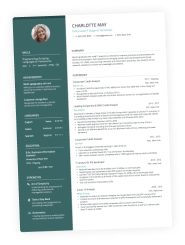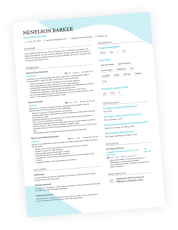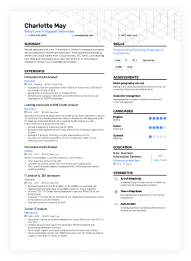Wondering whether or how you should include promotions on your CV?
The short answer is that you should always include promotions on your CV. They show you’re a top achiever in direct comparison with your colleagues, making your value to potential employers crystal clear.
Accolades like that can open exciting career opportunities. But, how to include previous roles and what information to include needs a bit more explanation, so read on!
In this article, we:
- Fully explain why it’s a great idea to include promotions on your CV.
- Describe 4 formats you can use to include promotions on your CV depending on your career stage and preference.
- List the pros and cons of each format to help you decide conclusively which is best for you.
- And we’ve included 4 examples showing you exactly how each format looks.
The importance of including promotions on your CV
Including promotions on your CV serves as tangible evidence of your career advancement, adding to your story by demonstrating professional growth, credibility, and commitment. This sets you apart as a candidate employers are looking for.
There aren’t many aspects of your CV that are so cut-and-dry beneficial. Consider these reasons to include promotions on your CV:
Demonstrates professional growth
Including promotions showcases your ability to excel and take on increasing responsibilities over time. It signals to potential employers that you’re able to grow into your job and beyond
Showing employers you have these qualities will serve you well in a competitive job market.
Enhances credibility
Promotions act as endorsements from your previous employers. They attest to your skills, performance, and adaptability in your profession.
Potential employers will see you as a candidate who can add value and navigate challenges effectively over the long run - highly valued characteristics in an employee.
Reflects commitment and loyalty
We live in a world of fast turnarounds and quick changes. However, employers still value candidates who’ve contributed meaningfully to their organisations over some time.
Displaying promotions on your CV shows a history of commitment and a track record of loyalty that potential employers will appreciate.
Sets you apart
A CV showcasing promotions distinguishes you from other candidates. It demonstrates your ability to thrive in the workplace and positions you as a desirable candidate for roles requiring experience and expertise.
Provides a comprehensive career story
Including promotions allows you to tell your professional story, providing context to your skills and achievements. Employers will gain insights into how you've evolved in your career, which can be instrumental in their decision-making process.
Formatting promotions on your CV
The entry format you choose for including promotions in your CV will influence how potential employers perceive your career growth. The format you choose will depend on your career history and personal preference on the structure of your CV.
Whichever approach you choose, the key is to present your promotions so they effectively communicate your professional growth and contributions. We recommend choosing from one of the following 4 methods that each offer a unique perspective on your professional journey.
Each format has its pros and cons, depending on what you want and need, so we’ve highlighted these also, to help you decide.
Stacked entries
The stacked entry format is best suited for when you’ve had linear career progression up through one company. For instance, if you moved up through Intern/Associate/Senior/Managing Editor.
For a stacked entry format, you list the company name once in your work experience section, followed by each job title individually below it - in a stack! As is most common for CVs, arrange your work experiences in reverse chronological order (most recent first), emphasising your career progression.
The stacked method ensures a clear visual representation of your career advancement within one organisation. Beneath the stack of job titles, provide a bullet list of concise, impactful details about your achievements and responsibilities to reinforce the value you brought through the roles.
Pros
Clear progression: Offers a straightforward visual representation of career advancement within one company.
Concise overview: Offers a quick snapshot of promotions, making it easy for recruiters to follow your career trajectory.
Coherent story: Maintains a cohesive connection between roles, showcasing a consistent dedication to a single organisation.
Cons
Limited detail: May provide less space for details on achievements and responsibilities in each role.
Potential to clutter: Stacking entries could lead to visual clutter. Especially if you’ve had multiple promotions with the same company.
Separate entries for each position
This format is best for highlighting progress in one company where you had less linear progression or even lateral movement in other departments. These entries will fall under a single company heading, but you’ll clearly outline job titles, dates (in reverse chronological order, and details for each.
Under each job title, elaborate on your achievements, emphasising the skills and contributions that led to your promotions. In the case of horizontal or lateral transfers, be sure to emphasise your flexibility and adaptability, which are highly prized soft skills.
Pros
Detailed Presentation: Offers more space to elaborate on achievements and contributions for each role.
Distinct phases: Clearly highlights different phases of your career, emphasising the unique responsibilities of each position.
Enhanced readability: Provides a clean and organised structure, enhancing readability.
Cons
Less immediate overview: May result in a longer CV, which might be less appealing for quick initial reviews.
Lengthier: As it’s longer, recruiters may need to invest more time to understand your career progression.
Listing the company twice
If you left a company for a period of time and then returned at a higher level, this format could be your best option.
Start with the company name, followed by the details of your initial position, including job title and dates. Then, create a separate entry for subsequent roles within the same company, repeating the company name.
This approach visually separates each position, emphasising distinct job titles and responsibilities. It provides a clear snapshot of your career evolution while maintaining a cohesive connection between roles within a single organisation.
Pros
Visual separation: Clearly distinguishes between different roles, emphasising the evolution in job titles and responsibilities.
Focused representation: Highlights the most relevant details for each position without potential visual clutter.
Cons
Repetition: May lead to redundant information since you mention the company name for each role.
Potential for confusion: Recruiters might need to navigate more to understand the chronological order of promotions.
Separate section
This format is less common but allows for a quick overview of your professional progress. In this method, you include a dedicated section titled "Promotions" or "Advancements."
Then, list each promotion along with corresponding job titles, company names, and dates in reverse chronological order. Don't include details about the roles in this case, just the progressive list of job titles.
This method will concisely overview your career growth in one section, streamlining a recruiter’s understanding of your professional progression. However, the brevity may lack clarity, so you may need to add descriptions, which could add too much bulk to your CV.
Pros
Concise: Streamlines the recruiter’s understanding of career growth in a dedicated section.
Growthorientation: Highlights promotions without the need for extensive details in the main work experience section.
Cons
Lessdetailed: Similar to stacked entries, this method will likely leave limited space for elaborating on achievements.
Potentialisolation: Separating promotions may isolate them from the context of specific job roles.
Quick tips
You should list promotions on your CV no matter which method you choose. Once you have, use the following checklist to ensure you haven’t overlooked anything.
Clarity and readability
Use a consistent, reader-friendly CV format with a clear font, uniform styling, and bullet points to maximise readability. A well-organised CV enhances the overall professional impression.
Use action verbs and quantify achievements
Including dynamic action verbs on your CV adds energy to your writing, and numbers substantiate your impact. They make your contributions more compelling to prospective employers.
For example, take a humdrum entry like:
- Responsible for a sales team of six.
Instead, it can be improved by writing something like:
- Successfully managed a 6-person sales team, leading to an 11% increase in sales in the first year.
Tailor to job descriptions
Customise your CV for each application by aligning your promoted experiences with specific job requirements. Incorporate relevant keywords from the job description to emphasise your suitability for the role.
Tailoring your CV for specific job applications demonstrates your attentiveness to the needs of each prospective employer. It allows you to hone in and show how you meet their particular needs.
Consideration for ATS (Applicant Tracking System)
It's crucial to optimise your CV for Applicant Tracking Systems nowadays. Many top employers use ATS to scan CVs for keywords and formatting, automating companies’ first stage of CV review.
But they’re ruthless.
While creating your CV, ensure important industry terms, skills, and job titles are strategically placed. Likewise, use standard month-year formats (mm, yyyy), which they more easily recognise.
Optimising your CV for ATS improves the chances it will pass through the initial job application stages.
Proofread for accuracy
Thoroughly proofread your CV to eliminate common CV mistakes, like errors in dates, job titles, and other details. Accuracy is paramount.
An error-free document conveys professionalism and meticulous attention to detail, enhancing credibility and leaving a positive impression.Errors are a red flag to recruiters, signalling sloppiness and low motivation.
The importance of formatting
It’s crucial to include the right info on your CV. But you also need to present it for maximum impact.
Strong formatting ensures recruiters can quickly and easily grasp the details of your promotions. Clear fonts, consistent styling, and organised layout contribute to overall readability.
Proper formatting also reflects professionalism, creating a positive impression on recruiters that you’re an organised, careful worker.
A well-formatted CV also makes it easier for recruiters to navigate and find specific information. This is particularly important when detailing promotions, as it helps recruiters understand your career progression timeline.
Finally, a clean and visually pleasing format enhances the overall aesthetics of the document. The visual appeal makes your CV more memorable and impactful, and can contribute to your personal branding.
With poor formatting, your hard work may not come across, and you’ll miss out on opportunities you’re well suited to.
How to format
Effectively use formatting to draw attention to key information, like job titles, company names, and dates. Judicious bold or italicised text, bullet points, and other formatting elements can help emphasise essential details.
Follow these quick formatting tips in general and for your CV promotions section:
- Apply a consistent font throughout your CV.
- Use bullet points for concise and easy-to-read content.
- Maintain uniform spacing and margins for a clean look.
- Clearly differentiate between sections using headers or bold text.
- Ensure dates, job titles, and company names are prominently displayed and formatted consistently.
- List your roles in reverse chronological order.
Examples
Look over our examples of each of the four formats we’ve described for including promotions on your CV to decide which best suits your application.
Stacked entries
Marchand Creative Solutions, London, UK | May 2016 - September 2022
Senior Project Manager | August 2020 - September 2022
Project Coordinator | January 2018 - August 2020
Assistant Project Coordinator | May 2016 - January 2018
- Successfully implemented a novel customer input and feedback system, resulting in a 20% increase in customer satisfaction.
- Coordinated multiple projects simultaneously, ensuring 100% on-time delivery with excellent client satisfaction.
- Developed and implemented a streamlined multi-team strategy, improving team communication and increasing production by 7%.
Separate entries
Hivemind Tech Solutions, Manchester, UK | June 2017 - Present
UX Design | March 2020 - Present
- Elevated user engagement by 11% and reduced bounce rates by 6.5% through impactful interface redesign.
- Accelerated project efficiency by 8% through seamless cross-functional collaboration based on multi-departmental understanding.
Software Engineer| June 2017 - March 2020
- Collaborated on the successful implementation of a major software upgrade, reducing system wait times by 13% overall.
- Resolved complex coding issues, improving software performance and resulting in 10% more favourable user experience.
List the company twice
InnoTech Ltd, Edinburgh, UK
Senior UX Designer | September 2019 – Present
- Pioneered user interface redesign, resulting in a 7% increase in app user retention.
- Implemented user feedback processes, leading to a 15% improvement in overall user satisfaction.
InnoTech Ltd, Edinburgh, UK
Junior UX Designer | January 2016- March 2017
- Executed user-centric design principles, enhancing the overall user experience of digital products.
- Collaborated with cross-functional teams to deliver visually appealing and functional designs.
Separate section
Promotions
Global Innovations, Bristol, UK
- Senior Marketing Manager | October 2020 – Present
- Marketing Coordinator | April 2018 - October 2020
- Assistant Marketing Coordinator | September 2016 - April 2018
- Marketing Intern | May 2016 - September 2016
Takeaways
- Including promotions on your CV substantiates how much other employers valued your work.
- You can choose from various formats to list promotions depending on the stage of your career, length requirements for your CV, and personal preference.
- Be sure to edit and maintain consistent, clear formatting for a polished professional look.
- Tailor your promotions section using keywords and use ATS-friendly formatting to ensure your CV gets through the early assessment stages.



